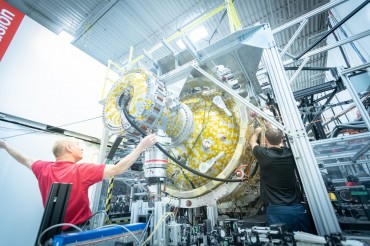
A new report by RIB Software reveals the urgent need for action to combat rising greenhouse gas emissions. (Image credit: Korea Bizwire)
With the Architecture, Engineering, and Construction (AEC) industry contributing more than 37% of global carbon emissions,a new report by RIB Software reveals the urgent need for action to combat rising greenhouse gas emissions. This not only a challenge for the AEC industry, but an imperative for mankind.
According to a panel of climate experts and scientists, greenhouse gas emissions are at an all-time high and accelerating at an unprecedented rate (1). What’s more, the pace and scale of climate action initiatives as a result of human-caused global warming have been insufficient.
This alarming reality means that industries need to intensify their efforts to reduce the environmental impact of CO2 emissions and embodied carbon, if they intend to meet environmental targets.
Stuttgart, Germany, Sept. 15, 2023 (Korea Bizwire) –
The role and impact of the AEC industry
“The RIB Sustainability Report 2023 paints a grim picture of an industry in dire need of change should it wish to mitigate the damages caused,” reveals René Wolf, Chief Executive Officer at RIB Software, a global leader in fit-for-purpose digital technologies for the engineering and construction industry.
As the silent yet impactful contributor to CO2 emissions, embodied carbon is one of the construction industry’s most pervasive environmental concerns. With a quarter of all industry-related embodied carbon emissions stemming from the extraction, manufacturing, transportation and installation of materials, the industry’s efforts fall short of its net-zero aspirations.
The need for awareness and accountability
With several hundred RIB customers responding from across the globe, the report highlights several concerning trends. Notably, an astonishing 74% of respondents do not track the embodied carbon emissions in their projects, and only 58% of those who do, do so for a limited number of projects.
Motivations for tracking their emissions vary, with 27% doing so to align with their company’s sustainability goals, while fewer than 25% doing so to meet their client’s objectives.
“Respondents cited several reasons for not tracking the emissions of their projects. Surprisingly, 45% claimed that it is not a priority for their clients, while 26% cited a lack of knowledge about effective measurement techniques. Addressing these concerns, we believe that it is pivotal to create a paradigm shift in industry practices,” adds Wolf.
The survey reveals clear signs of a perception gap, with the majority of respondents underestimating the significance of the industry’s carbon emissions. Here, only half believe that they are responsible for driving change, while 25% acknowledge that tracking embodied carbon is an ethical imperative.
Paving the path to change
“While the challenges persist, there are signs of progress. Over 80% of companies tracking their embodied carbon emissions have been doing so for less than five years, with promising outcomes. Approximately 77% utilize Environmental Product Declaration (EDP) databases, while 68% employ digital tools to track and reduce the carbon footprints of their projects,” he says.
Though only half of the surveyed companies have carbon reduction strategies in place and 45% have dedicated employees in place to drive sustainable initiatives, there is a glimmer of light at the end of the net-zero tunnel.
Collaboration needed to drive change
A third of respondents have formally committed to reducing embodied carbon emissions, driven by multiple factors, with legislation (33%), client expectations (28%), and cost/efficiency savings (18%) emerging as the primary catalysts.
“Carbon reduction in the AEC industry requires a collaborative effort that involves various stakeholders, each with a unique role to play in minimizing the project’s environmental impact,” adds Wolf.
As such, architects, designers, engineers, contractors, suppliers, manufacturers, clients, developers, researchers, regulatory bodies and government need to unite and promote energy efficiency, low-carbon materials and sustainable practices at every turn.
Building a sustainable legacy
Collaboration among these stakeholders is essential to achieve meaningful carbon reduction in construction projects. Effective communication, shared goals, and a commitment to sustainability at every stage of the project lifecycle will undoubtedly contribute to and result in a more environmentally responsible built environment.
“The construction industry is at a pivotal juncture, tasked with not just erecting structures, but also building a sustainable legacy. These insights underscore the need for collective action to bridge the gap between intentions and impact.
“As stakeholders within this dynamic landscape, the onus is on us to drive transformation, advocate for informed decisions, and pioneer innovative strategies and technologies that lead us to a future where efficiency and sustainability is not just a goal, but a way of life,” concludes Wolf.
References
1. Greenhouse gas emissions at “an all-time high” — and it is causing an unprecedented rate of global warming, say scientists [Internet]. ScienceDaily. [cited 2023 Aug 22]. Available from: https://www.sciencedaily.com/releases/2023/06/230608121013.htm
About RIB Software
Driven by transformative digital technologies and trends, RIB is committed to propelling the industry forward and making engineering and construction more efficient and sustainable.
Throughout its 60-year history, the business has expanded its global footprint to incorporate more than 550,000 users and 2,300 talents, with the vision of transforming the operation into a worldwide powerhouse and providing innovative software solutions to its core markets – while placing its people at the heart of everything it does.
Managing the entire project lifecycle, from planning and construction, to operation and maintenance, the development of RIB’s portfolio of software solutions is driven by industry expertise, best practice and a passion to remain at the cutting edge of technology.
Ultimately, it aims to connect people, processes and data in innovative ways to ensure its customers always complete projects within budget, on time and to high quality, while reducing their carbon footprints.
RIB Software is a proud Schneider Electric company.
Kim Immelman
Attachment

Kim Immelman
Source: RIB Software via GLOBE NEWSWIRE







